The Relationship between the Five Elements
- Mutual generation cycle
- Mutual restriction cycle
- Over-restriction
- Reverse restriction
- Balance between generation and restriction
Mutual generation cycle
This cycle refers to the manner in which the elements create one another. Wood easily burns and makes a fire. Fire produces ash, creating earth. The earth contains mineral from which metal is mined and extracted. When metal is heated and cooled, water droplets will be collected over the metal as a result of condensation, thus metal creates water. Water promotes the growth of trees, which are wood. Wood generates fire; fire generates earth; earth generates metal, metal generates water, water generates wood, and again wood generates fire; they form a cyclic order that gives rise to change and transformation constantly.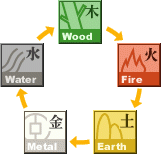 |
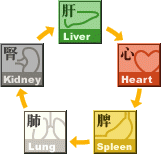 |
| This cycle shows how the five elements generate one another | This cycle shows how the five organs promote one another |
Index: ![]() Generates
Generates
Mutual restriction cycle
This cycle refers to the manner in which the elements restrict and control one another. Wood breaks up the soil and depletes the earth's nutrients, thus controlling earth. Earth contains water in many places, and as dam prevents flooding, earth controls water. Water extinguishes fire, and therefore, controls its spread. Fire controls metal by its ability to melt it. Metal can be made into an axe that cuts wood into pieces, thus controlling wood. Wood controls earth; earth controls water; water controls fire, fire controls metal, metal control wood; and again wood control earth. The control repeats in a cyclic fashion and provides an opposite force to balance the generative power. The generation and restriction properties of the five elements hold each other in check, preventing over-functioning.
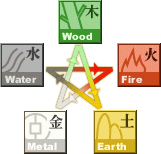 |
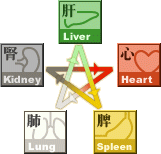 |
| This cycle shows how the five elements restrict one another | This cycle shows how the five organs restrict one another |
Index: ![]() restricts
restricts
Over-restriction
The Chinese word for restriction, "ke" means "inhibition" or "winning over". In nature, wood controls the earth; inside the body, the liver (wood element) controls the spleen (earth element) and inhibits its functions in a balanced manner. If the liver's control becomes excessive, it will inhibit spleen functioning, causing an imbalance in the body. This can be due to either the liver is too powerful or the spleen is too weak.
Reverse restriction
If the enemy is too strong, the controlling element itself becomes controlled in a reverse manner (i.e. the original restriction is insufficient). When wood is too strong and its controlling metal axe is too blunt, the axe cannot cut the wood and may even break as a result of the rebound force if an attempt is made to chop it. This illustrates reverse restriction because the wood is able to restrict metal, which is not usually the case. In our body, if the liver functions excessively, its controlling lung will also be restricted in a reverse manner. The excessive liver function will produce heat and qi disturbance, that individuals not only develop irritability, flush face, bloodshot eyes, chest side discomfort, the lung's breathing will be affected and may even develop coughing with blood.Balance between generation and restriction
In the Ming Dynasty, a famous TCM physician Zhang JingYue (1563〜1640 AD) said, "The mechanism of creation cannot do without generation. Neither can it do without restriction. If there is no generation, there will be no development and growth. If there is no restriction, the unbalanced excitement will be harmful." It is necessary to have restriction within the generation and to have generation within the restriction, they complement each other so that everything can operate continuously. Balance between generation and restriction is important for normal operation of the five elements. Each element is under the influence of the other four in some way. Wood generates fire and water generates wood. On the other hand, wood inhibits earth, but itself is inhibited by metal. In this way, all five elements establish an intricate homeostasis in nature. This wisdom has also been applied to TCM by incorporating the theory of the five elements into health maintenance strategies, which have been successful for thousands of years.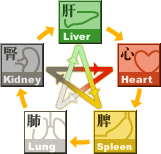
Index:


